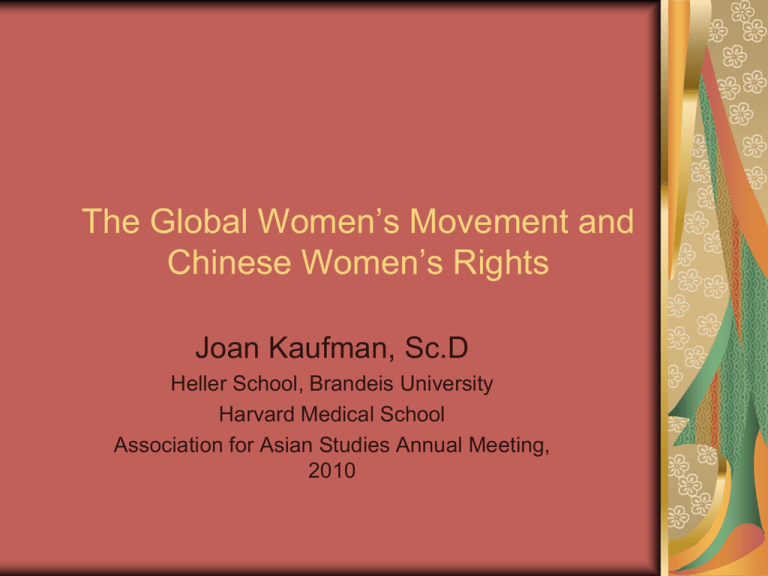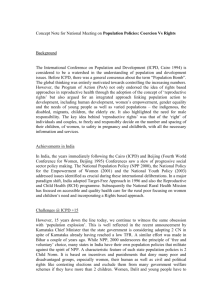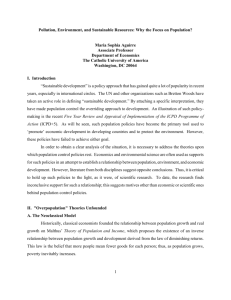
The Global Women’s Movement and
Chinese Women’s Rights
Joan Kaufman, Sc.D
Heller School, Brandeis University
Harvard Medical School
Association for Asian Studies Annual Meeting,
2010
Key Points
Global Women’s movement as trans national civil
society movement advocating for and mobilizing
about women’s rights
Two UN Conferences on Women in 1990’s as
vehicles for making global connections
Beijing Women’s Conference in 1995 as
galvanizing and catalytic event for Chinese
women’s movement
Overview of Presentation
The Global Women’s Movement and the two UN
Conferences:
International Conference on Population and
Development (ICPD), Cairo, 1994
Fourth World Conference on Women, Beijing
(4WCW), 1995
Impact of ICPD and 4WCW in China
Resulting initiation of reforms to China’s family
planning program and domestic violence efforts
The International Conference on Population
and Development (Cairo,1994)
Victory for feminist critiques of
population control programs
Primacy of reproductive health and
rights and women’s social and
economic development over narrow
focus on birth control
ICPD, Platform for Action, 1994
Reproductive and Sexual Rights
Reproductive health, including family planning,
MCH, HIV and STI instead of population control
Quality services and informed choice
Services and information to youth
Domestic violence as health issue
Client centered and integrated services
Social and economic development for women
Role of civil society and non government actors
China’s Family Planning Program in 1994
Child bearing women targeted
Demographic targets down to local level
Government regulations and fines for
unplanned births
Parity driven: emphasis on long term
methods
pressure to abort unplanned pregnancies
Highly organized service and propaganda
infrastructure
“One veto” system for evaluating officials
China’s Family Planning Program
Reform after 1994
1995 – 1997: Pilot Project on Quality of
Care and Reproductive Health (11 rural
counties)
1999: scaled up to 800 counties (25% of
country) and groundswell for change
2000: government announced plan to
expand to whole country by 2010
2001: laws and regulations reformed and
publicized
Key Aspects of the Reform Initiative
Eliminate township level population targets
(retained at county but normative)
Contraceptives based on need/preference
not parity driven
Informed choice of methods and
counseling
Reform supervision and evaluation criteria
for family planning cadres
Add needed health services (RTI and HIV)
China’s Family Planning Reform:
Not far enough
Change in rhetoric and intention from target driven
to need based and service oriented and
contraceptive choice
Little change in reproductive rights
The Girl Child: sex ratio at birth 117 boys to 100
girls through sex selective abortion and girl child
abandonment: second and third parity
No civil society movement in China advocating for
reproductive rights
Silence and mixed messages by China’s feminists
The Fourth World Conference on Women
Beijing, 1995
Re-affirmed ICPD agenda on reproductive health and rights
and women’s social and economic rights
Domestic Violence as one of four key conference themes
NGO Forum: active role of international women’s NGOs
Advocacy Groups and Civil Society Organizations (DAWN,
WEDO, HERA, IWHC)
Chinese women’s NGO’s emerged as “counterparts” to
global actors – Women’s Hotline, Women’s Law Center of
Beijing University, Chinese Women’s Health Network, Rural
Women Knowing All
Regional organizations strengthened – ARROW
International Networking and Alliance building on women’s
issues
Beijing Conference, Post 1995
Impact on China’s Women’s Movement
Galvanizing event for Chinese women activists through
exposure to international women’s movement especially
international NGOs
Further consolidation of women’s activist NGOs and
networks working on women’s social and economic issues
(e.g. women’s media project, domestic violence network)
Launch of China gender and development group
Growth of women’s studies, research and training (Chinese
Society for Women’s Studies, ACWF’s China Women’s
Studies Association)
Beginning of international networking via internet (e.g.V-Day
campaigns)
Changing Role of All China Women’s
Federation
Hosting of Beijing Conference and ongoing
participation in CSW and contact point for
UN women’s rights agreements
Growing activism by provincial and county
branches of ACWF (e.g. Xi’an)
Independent NGOs putting pressure on
ACWF to change and become more
responsive to women’s issues: domestic
violence, trafficking, job discrimination,
women’s land inheritance rights
Progress on Domestic Violence after Beijing
Conference, 1995
Pre Beijing Conference, denial
Domestic Violence Network formed in 1998 (10 NGO and
academic groups)
Local branches of ACWF began anti DV legal initiatives after
Beijing Conference
2001 Marriage Law amended to include a law outlawing
domestic violence/2005 LRIW amended – remedial
measures included
2007 – drafting of law on domestic violence by Domestic
Violence Network (to be submitted to State Council)
2008 – Guide for Supreme People’s Court issued on
domestic violence and “protection orders” mechanism
established
Comparison of Progress on Reproductive
Rights and Domestic Violence
Reproductive Rights issue – institutional reform (National
Population and Family Planning Commission) but no
independent NGO movement
ICPD commitments led to top down reforms to family planning program
No civil society actors putting pressure on government about women’s
rights violations of the program
Domestic Violence issue – interplay between evolving
ACWF and civil society driven women’s movement
Beijing Conference “issue” pushed ACWF to act and internationalized it
(e.g. CSW)
Independent civil society groups put further pressure on ACWF
Competition for legitimacy as representatives of women’s interests
Huge growth in NGOs in China
320,000 NGOs registered with MOCA
171,150 shehui tuanti –social organizations
975 Jijinhui -foundations
147,637 minbanfeiqiye danwei – welfare orgs
but probably 2 million (commercial and industrial bureau,
community organizations, rural welfare and mutual help
groups, religious groups)
Mainly advocacy (changdao) rather
than service
Dual management system
Conclusion
Government policies, programs and
services have been instrumental to
advance basic women’s rights in China
However, voice and agency of women
(through civil society) are critical
mechanisms for fuller rights achievement
Transnational civil society needs
“counterparts” at national level in order to
mobilize action on specific issues











